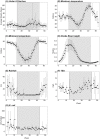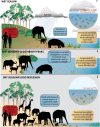Hydrometeorology and flood pulse dynamics drive diarrheal disease outbreaks and increase vulnerability to climate change in surface-water-dependent populations: A retrospective analysis
- PMID: 30408029
- PMCID: PMC6224043
- DOI: 10.1371/journal.pmed.1002688
Hydrometeorology and flood pulse dynamics drive diarrheal disease outbreaks and increase vulnerability to climate change in surface-water-dependent populations: A retrospective analysis
Abstract
Background: The impacts of climate change on surface water, waterborne disease, and human health remain a growing area of concern, particularly in Africa, where diarrheal disease is one of the most important health threats to children under 5 years of age. Little is known about the role of surface water and annual flood dynamics (flood pulse) on waterborne disease and human health nor about the expected impact of climate change on surface-water-dependent populations.
Methods and findings: Using the Chobe River in northern Botswana, a flood pulse river-floodplain system, we applied multimodel inference approaches assessing the influence of river height, water quality (bimonthly counts of Escherichia coli and total suspended solids [TSS], 2011-2017), and meteorological variability on weekly diarrheal case reports among children under 5 presenting to health facilities (n = 10 health facilities, January 2007-June 2017). We assessed diarrheal cases by clinical characteristics and season across age groups using monthly outpatient data (January 1998-June 2017). A strong seasonal pattern was identified, with 2 outbreaks occurring regularly in the wet and dry seasons. The timing of outbreaks diverged from that at the level of the country, where surface water is largely absent. Across age groups, the number of diarrheal cases was greater, on average, during the dry season. Demographic and clinical characteristics varied by season, underscoring the importance of environmental drivers. In the wet season, rainfall (8-week lag) had a significant influence on under-5 diarrhea, with a 10-mm increase in rainfall associated with an estimated 6.5% rise in the number of cases. Rainfall, minimum temperature, and river height were predictive of E. coli concentration, and increases in E. coli in the river were positively associated with diarrheal cases. In the dry season, river height (1-week lag) and maximum temperature (1- and 4-week lag) were significantly associated with diarrheal cases. During this period, a 1-meter drop in river height corresponded to an estimated 16.7% and 16.1% increase in reported diarrhea with a 1- and 4-week lag, respectively. In this region, as floodwaters receded from the surrounding floodplains, TSS levels increased and were positively associated with diarrheal cases (0- and 3-week lag). Populations living in this region utilized improved water sources, suggesting that hydrological variability and rapid water quality shifts in surface waters may compromise water treatment processes. Limitations include the potential influence of health beliefs and health seeking behaviors on data obtained through passive surveillance.
Conclusions: In flood pulse river-floodplain systems, hydrology and water quality dynamics can be highly variable, potentially impacting conventional water treatment facilities and the production of safe drinking water. In Southern Africa, climate change is predicted to intensify hydrological variability and the frequency of extreme weather events, amplifying the public health threat of waterborne disease in surface-water-dependent populations. Water sector development should be prioritized with urgency, incorporating technologies that are robust to local environmental conditions and expected climate-driven impacts. In populations with high HIV burdens, expansion of diarrheal disease surveillance and intervention strategies may also be needed. As annual flood pulse processes are predominantly influenced by climate controls in distant regions, country-level data may be inadequate to refine predictions of climate-health interactions in these systems.
Conflict of interest statement
The authors have declared that no competing interests exist.
Figures





Similar articles
-
Overcoming barriers in evaluating outbreaks of diarrheal disease in resource poor settings: assessment of recurrent outbreaks in Chobe District, Botswana.BMC Public Health. 2013 Aug 26;13:775. doi: 10.1186/1471-2458-13-775. BMC Public Health. 2013. PMID: 23971427 Free PMC article.
-
Hydrological Regime and Water Shortage as Drivers of the Seasonal Incidence of Diarrheal Diseases in a Tropical Montane Environment.PLoS Negl Trop Dis. 2016 Dec 9;10(12):e0005195. doi: 10.1371/journal.pntd.0005195. eCollection 2016 Dec. PLoS Negl Trop Dis. 2016. PMID: 27935960 Free PMC article.
-
Climate change is likely to worsen the public health threat of diarrheal disease in Botswana.Int J Environ Res Public Health. 2013 Mar 26;10(4):1202-30. doi: 10.3390/ijerph10041202. Int J Environ Res Public Health. 2013. PMID: 23531489 Free PMC article.
-
Vulnerability of waterborne diseases to climate change in Canada: a review.J Toxicol Environ Health A. 2004 Oct 22-Nov 26;67(20-22):1667-77. doi: 10.1080/15287390490492313. J Toxicol Environ Health A. 2004. PMID: 15371208 Review.
-
Heavy rainfall and waterborne disease outbreaks: the Walkerton example.J Toxicol Environ Health A. 2004 Oct 22-Nov 26;67(20-22):1879-87. doi: 10.1080/15287390490493475. J Toxicol Environ Health A. 2004. PMID: 15371222 Review.
Cited by
-
Human-mediated impacts on biodiversity and the consequences for zoonotic disease spillover.Curr Biol. 2021 Oct 11;31(19):R1342-R1361. doi: 10.1016/j.cub.2021.08.070. Curr Biol. 2021. PMID: 34637744 Free PMC article. Review.
-
Modeling Future Projections of Temperature-Related Excess Morbidity due to Infectious Gastroenteritis under Climate Change Conditions in Japan.Environ Health Perspect. 2019 Jul;127(7):77006. doi: 10.1289/EHP4731. Epub 2019 Jul 19. Environ Health Perspect. 2019. PMID: 31322439 Free PMC article.
-
Interventions addressing impacts of climate change on sexual and reproductive health and rights in sub-Saharan Africa: A scoping review.PLoS One. 2025 Aug 11;20(8):e0329201. doi: 10.1371/journal.pone.0329201. eCollection 2025. PLoS One. 2025. PMID: 40788888 Free PMC article.
-
Taxonomy for citizen actions on public health and climate change: a proposal.Rev Saude Publica. 2022 Jan 5;55:119. doi: 10.11606/s1518-8787.2021055003823. eCollection 2022. Rev Saude Publica. 2022. PMID: 35019053 Free PMC article.
-
Understanding the Impact of Rainfall on Diarrhea: Testing the Concentration-Dilution Hypothesis Using a Systematic Review and Meta-Analysis.Environ Health Perspect. 2020 Dec;128(12):126001. doi: 10.1289/EHP6181. Epub 2020 Dec 7. Environ Health Perspect. 2020. PMID: 33284047 Free PMC article.
References
-
- Patz JA, Vavrus SJ, Uejio CK, McLellan SL. Climate change and waterborne disease risk in the Great Lakes region of the US. Am J Prev Med. 2008;35(5):451–8 - PubMed
-
- Boithias L, Choisy M, Souliyaseng N, Jourdren M, Quet F, Buisson Y, et al. Hydrology and human behavior: two key factors of diarrhea incidence in montane tropical humid areas. 19th EGU General Assembly; 2017 Apr 23–28; Vienna, Austria.
-
- Anthonj C, Rechenburg A, Höser C, Kistemann T. Contracting infectious diseases in sub-Saharan African wetlands: a question of use? A review. Int J of Hyg Environ Health. 2017;220(7):1110–23. - PubMed
Publication types
MeSH terms
Grants and funding
LinkOut - more resources
Full Text Sources
Medical
Research Materials

